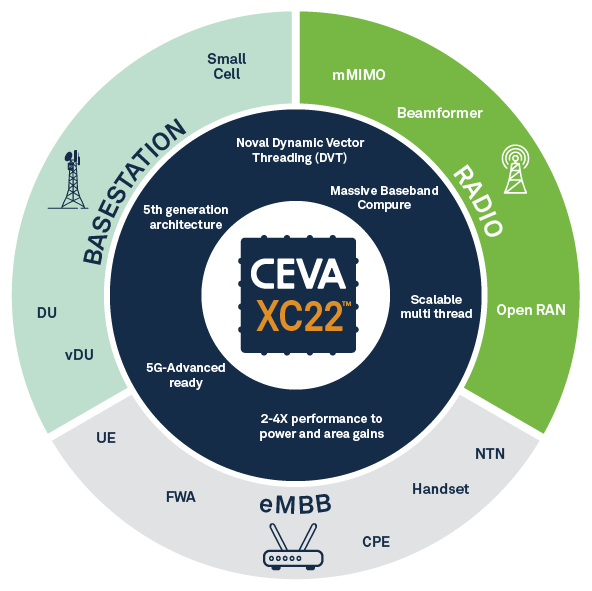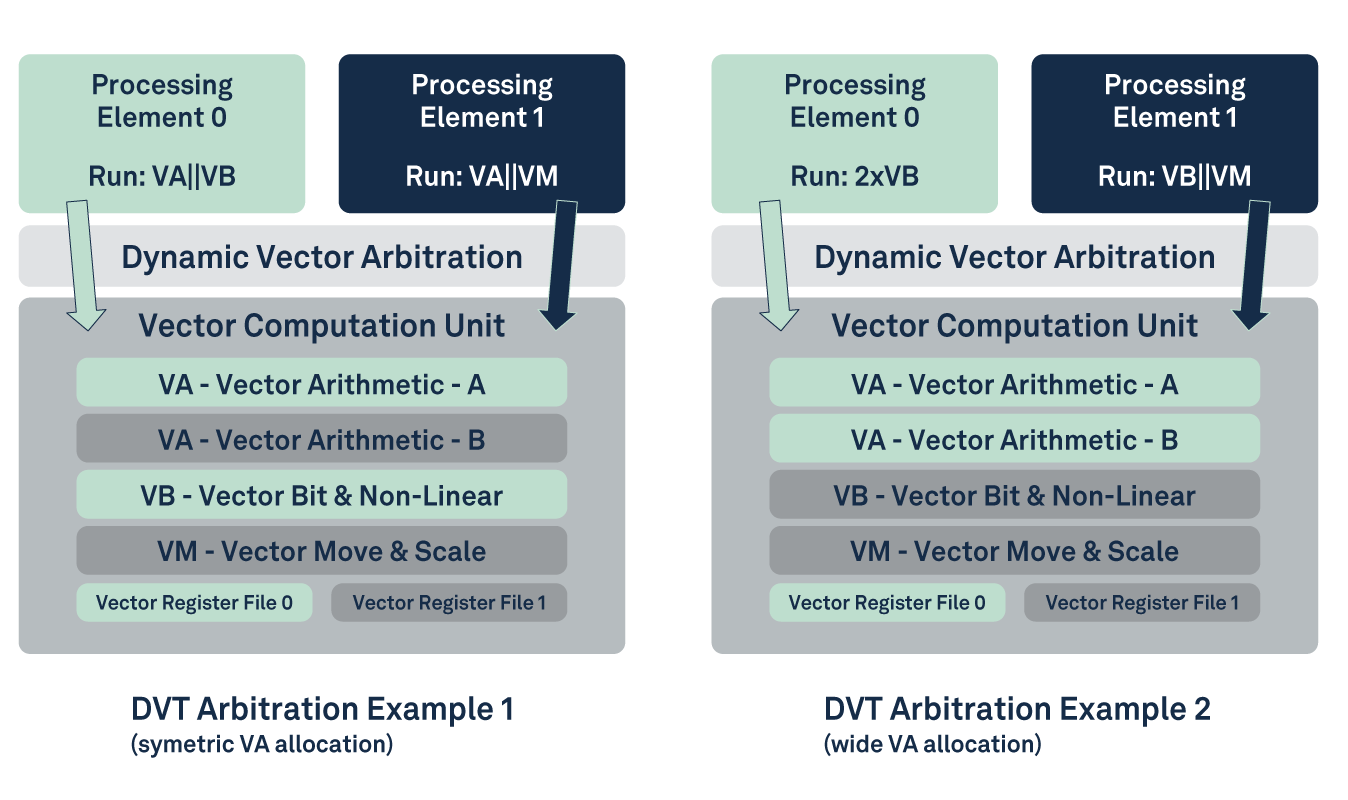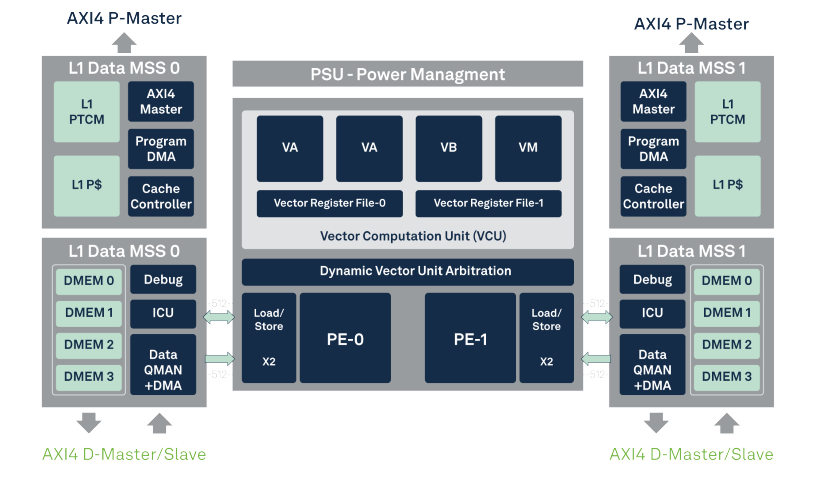Industry’s Most Comprehensive 5G Baseband Platform IP for Mobile Broadband and IoT
Ceva-PentaG2 is Ceva’s second generation 5G NR baseband modem IP platform. It is the industry’s only...
The World’s Most Advanced Vector Baseband Processor
The Ceva-XC22 DSP, based on Ceva’s 5th generation Ceva-XC20™ architecture, is the world’s most advanced and efficient vector DSP, targeted for intense 5G and 5G-Advanced workloads in both high-end UE and Infrastructure devices. Ceva-XC22 supports two independent execution threads and uses Ceva’s unique Dynamic Vector Threading (DVT) scheme to optimally share large vector compute resources, and dramatically increase vector compute efficiency compared to other vector DSP implementations. This dramatic efficiency gain is manifested across a wide range of 5G-Advanced use cases and compute kernels, and solves the biggest pain in vector DSP architectures: how to increase utilization of the most significant resource (in terms of area) in vector DSPs, being the vector arithmetic and compute unit.
Being particularly efficient when handling multiple compute tasks, Ceva-XC22 is ideally suited for advanced 5G use cases that involve massive and multiple compute needs that are common in 5G UE terminals (e.g. Fixed Wireless Access supporting multiple component carries, or doing various channel estimation tasks) and in Cellular Infrastructure (in both DU/vDU processing and Massive MIMO RRUs) .

The Ceva-XC22 DSP is based on a unified scalar and vector-processing platform, using two independent scalar processing elements, each coupled to an independent Program and Memory Sub-Systems, to facilitate true simultaneous and symmetric multithreading operation.
The Ceva-XC22 uses enhanced Vector Compute Unit (VCU) with two Vector Arithmetic (VA) engines, a Vector Bit & Non-Linear engine (VB) and a Vector Move and Scale engine (VM). These are optimally utilized using the Dynamic Vector Threading (DVT) scheme. Each of the two execution threads has a separate Vector Register file to save vector context, to fully support true HW multi-thread. A novel Dynamic Vector Unit Arbitration schedules simultaneous vector execution commands, per cycle, across the four vector execution units, and resolves run-time contentions. As such, the two execution engines can access the vector resources in parallel. Arbitration dynamically supports wide allocations to one of the processing elements, or symmetric allocations for the two elements. This dramatically increases the VCU compute utilization, as in most cases, tasks can run uninterrupted and do not contend on the vector unit at the same pipeline stage. Efficiency gains can reach 2.5X and more relative to previous generation architecture. The new design concepts boost the performance per area for intense 5G use cases, and significantly reduce the size for implementations requiring large number of cores.

The Ceva-XC22 supports very wide memory access for efficiently feeding the VCUs. Two load/store units per execution element support 1024-bit access from tightly coupled local data memory. Overall, this constitutes a formidable 2048-bit memory access, achieving unprecedented performance targets for intense 5G and 5G Advanced use cases.
Ceva-XC22 is also integrated within Ceva’s 5G baseband platforms, The Ceva-PentaG2 Max™ for eMBB UE devices, and the Ceva-PentaG RAN™, for cellular infrastructure, where it is part of heterogeneous compute platforms, including both DSPs and 5G specific compute and acceleration engines.
Benefits
Designed to meet the demanding requirements of modern 5G and 5G-Advanced networks for extreme multi gigabit, multi carrier, and ultra-short latency baseband computing
Scalable Ceva-XC20 architecture addresses the full range of cellular baseband processing needs, for both Cellular Infrastructure and high-end UE terminals
World’s most powerful and efficient baseband compute platform, delivering 2.5X efficiency gain compared with its predecessor
Innovative Dynamic Vector Threading architecture, utilizing two scalar execution processors, enabling true simultaneous multi thread operation with dynamic VCU resource allocation
Main Features
- Fully programmable DSP architecture incorporating unique mix of VLIW and SIMD vector capabilities
- 8-way issue VLIW provides optimal hardware utilization across both Vector and Scalar resources
- Dual scalar processors for running true multi-threading, with separate program and data memory sub-systems, with dynamic VCU resource allocation per thread
- Extremely powerful vector processor supports 128 MACs per cycle and 2048-bit wide memory bandwidth
- Advanced Data Memory sub-system, divided into blocks to support uninterrupted access for parallel load and store, simultaneously with DMA data movement into and out of the core
- Queue Manager for handling DMA into and out of the core over optional auxiliary AXI ports
- Separate Program Memory Subsystem per processing element, supporting both local cache and TCM
- Advanced pipeline architecture achieving very high clock speeds
- Utilizing advanced scalar cores for the two execution threads, with optimizing LLVM C compiler for protocol, control, and DSP native C code supports very low overhead RTOS multi-tasking with dynamic branch prediction
- Core streaming interfaces support ultra-low latency
- AMBA 4 compliant matrix interconnect
Block Diagram



